Class 11 Economics Chapter 6 Non – competitive Markets, (Assam Higher Secondary Education Council) AHSEC Class 11 Economics Question Answer in English Medium each chapter is provided in the list of AHSEC so that you can easily browse through different chapters and select needs one. Assam Board Chapter 6 Non – competitive Markets Class 11 Economics Question Answer can be of great value to excel in the examination.
AHSEC Class 11 Economics Chapter 6 Non – competitive Markets
Class 11 Economics Chapter 6 Non – competitive Markets Notes cover all the exercise questions in SCERT Textbooks. The SCERT Class 11 Economics Chapter 6 Non – competitive Markets Solutions provided here ensure a smooth and easy understanding of all the concepts. Understand the concepts behind every chapter and score well in the board exams.
Non – competitive Markets
Chapter – 6
PART – A
VERY SHORT ANSWER QUESTIONS
1. Define monopoly.
Ans: Monopoly is a market situation, where there is a single seller or producer and a large number of buyers for a commodity for which, no close substitutes are available in the market.
2. What does the market demand curve express for a monopoly firm ?
Ans: Downward sloping
3. Fill in the blanks:
Under monopoly, when the TR shows a fail, the MR takes a ______ ( negative/ positive) value.
Ans: negative.
4. Name the market structure in where with the condition of free entry and exit a large number of firms produces goods which are not homogenous.
Ans: Monopolistic Competition.
5. Write true or false:
The demand curve faced by the monopolistic firm is horizontal.
Ans: False.
6. Define Oligopoly.
Ans: Oligopoly is said to prevail, when there are few firms in the market producing a product.
7. What is duopoly ?
Ans: Duopoly is a special kind of oligopoly, where there are only two firms of a commodity
8. Write true or false:
The monopolist is a price taker.
Ans: False.
9. Write true or false:
The less competitive the market structure, the more competitive is the behaviour of firms towards each other.
Ans: False.
10. Choose the correction:
The market of a particular commodity consists of more than one seller but the number of sellers is few, the market structure is called_______. ( Oligopoly/ Duopoly/ Monopoly)
Ans: Duopoly.
11. Fill in the blank:
Profit = TC ― ____.
Ans: Profit = TC ― TR.
12. Choose the curve faced by the firms under monopolistic competition is_____. ( Perfectly elastic/ not perfectly elastic).
Ans: Not Perfectly elastic.
13. What is the significance of ‘brand-name’ of products produced by different firms under monopolistic competition.
Ans: Goods are not homogenous.
14. Mention a basic feature of monopolistic competition.
Ans: Product Differentiation.
15. State ‘Yes’ or ‘No’
Can a monopolist sell a larger quantity at a higher price.
Ans: Yes.
16. Define Monopolistic competition ?
Ans: Monopolistic competition refers to a market situation wherein there are large number of small firms/ sellers selling differentiated but closely related products.
17. Define your correct answers:
Under perfect competition market demand curve is ARC/MRC/TRC
Ans: ARC.
18. What type of product prevail in a monopoly market ?
Ans: No close substitute product.
19. Fill in the blanks:
The special case of oligopoly where there are exactly two sellers is termed as ____.
Ans: duopoly
20. State true or false:
The goods produced by the monopolistic competition are not homogeneous.
Ans: True.
SHORT ANSWER QUESTION TYPE -II:(MARKS : 3)
1. During long-run firms can not earn profit but this is not the case with monopoly firm why ? ― explain.
Ans:
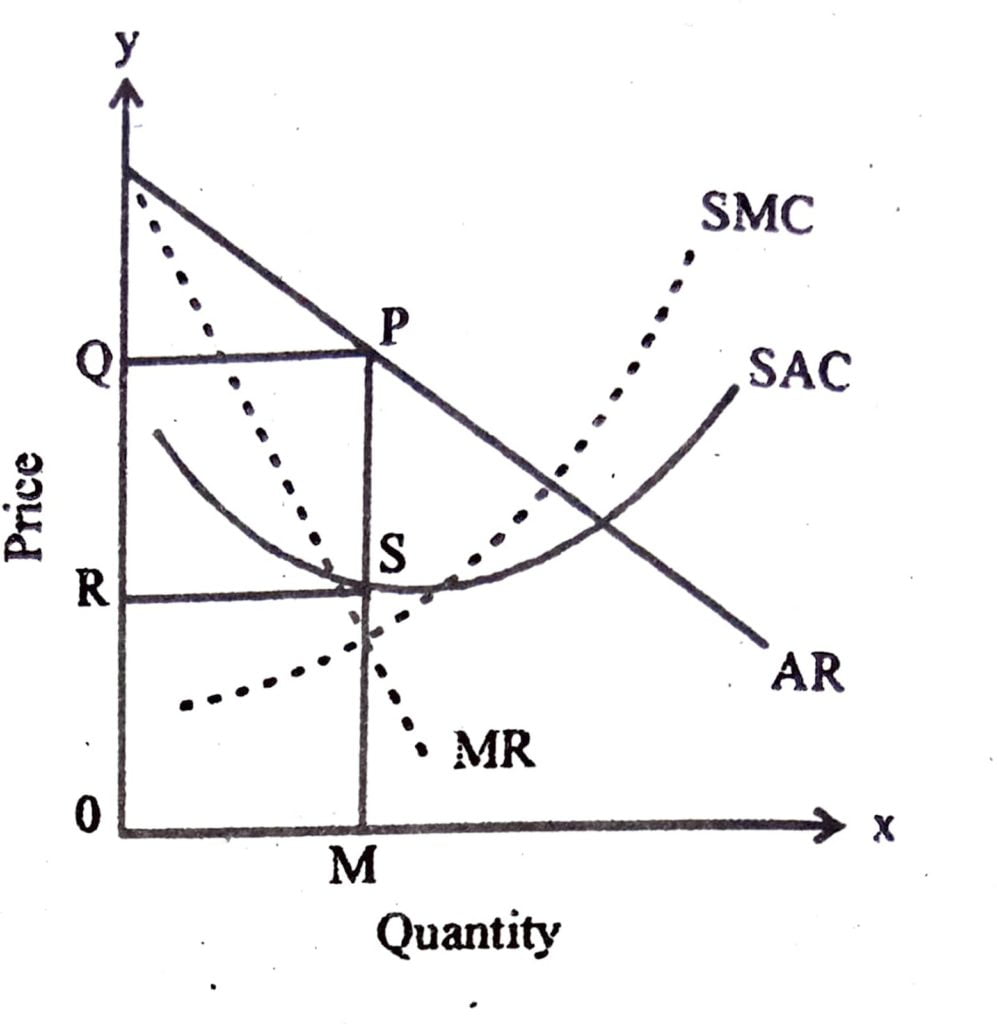
In a monopoly market, a single firm controls the entire output of a commodity. The commodity produced by a monopolist has no substitute. A monopolist is guided by profit motive . He will fix that price and output, which will give him maximum possible net profit. A monopolist in the long run will attain equilibrium when MR= MC.
In the short period, the monopolist behaves like any firm. His aim is minimization of losses. Profits are maximised when marginal cost is equated to marginal revenue. A monopolist with no close substitute of his product should be able to keep the price of his product at least equal to fit short run average cost, so as to avoid losses. But a monopolist referring losses in the short run is not an impossibility.
The attached figure shows the determination of price and output by a monopolist. The output at which his marginal cost curve(SMC) equals his marginal revenue curve is OM. It is the equilibrium output.
At this output, the average revenue (price) is MP and average cost(SAC) is MS. Per unit profit is MP=MS=PS. The total profit area is PSRQ.
2. Show the relationship between marginal revenue of a monopoly firm and price elasticity of demand.
Ans: The relationships are as follows:
(a) When MR is positive, price elasticity of demand is more then one.
(b) When MR is negative, price elasticity of demand is less then one.
(c) When MR becomes smaller, the quantity of the Commodity increases and price elasticity of demand also becomes smaller.
3. Explain why does the long run profit become zero for firms under monopolistic competition.
Ans:
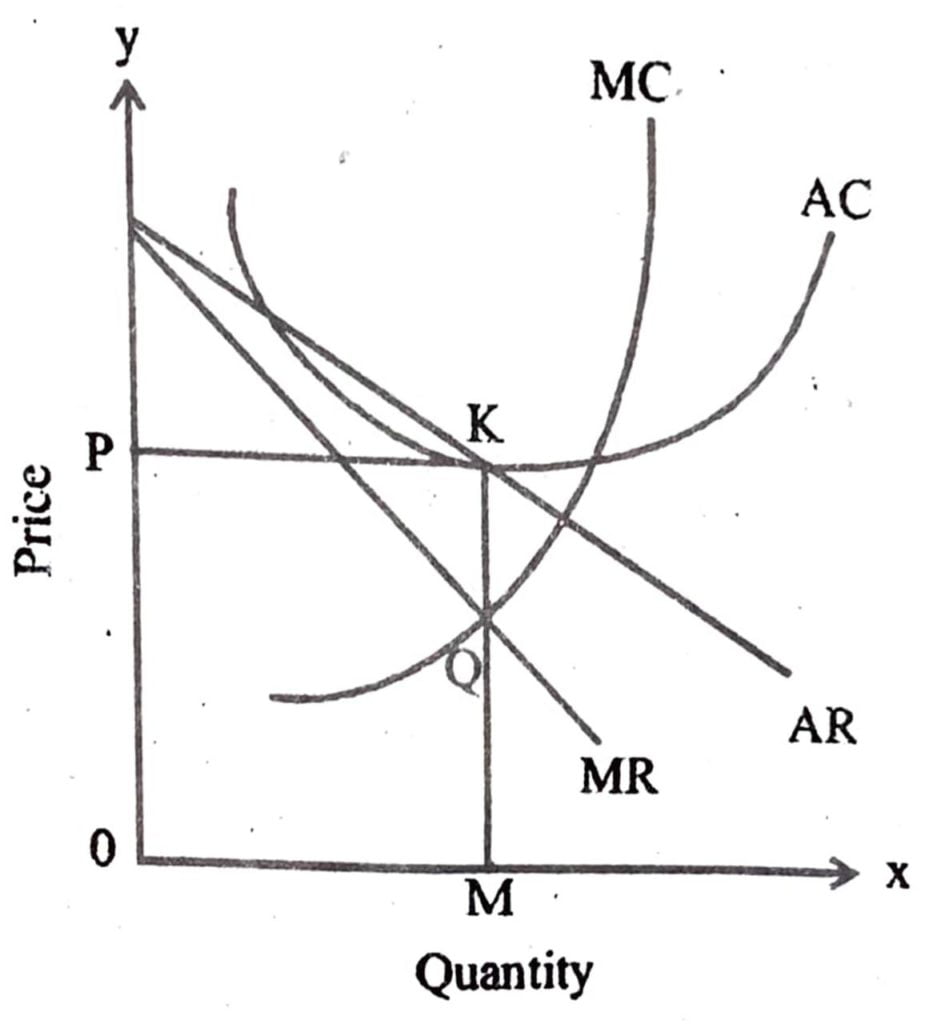
All firms under monopolistic competition will earn only normal profit in the long run. Supernormal profit earned by some firms during the short period attract new firms to enter into the industry, leading to a fall in the average revenue. On the other hand, loss incurring enterprises will leave the industry in the long run, leading to increase in the average revenue of the remaining firms. In the long run, all firms under monopolistic competition will earn only normal profit and thus, average revenue of these firms will be equal to their average cost (AR=AC)
Thus, all firms under monopolistic competition will be in equilibrium when not only their marginal revenue will be equal to their marginal cost, but also their average revenue will be equal to their average cost. Thus, in the long run, the conditions for equilibrium is MR=MC and AR=AC.
In the beside figure, the average revenue curve AR is tangent to the Average cost curve AC at point K and thus, here AR=AC. At this point, the equilibrium output is OM and the equilibrium price is OP, which is again equal to average cost. At the output OM, the marginal revenue is also equal to marginal cost at point Q. At point K, as there is no difference between average revenue and average cost, thus, there is neither supernormal profit nor losses. There is only normal profit.
4. Argue that the existence of monopolies may be beneficial to society.
Ans: See Q. No. 3 ( Long Type)
5. Can you say that a pure monopoly situation never exists._ Explain briefly.
Ans: See Q. No. 5 (Long Type)
6. The marginal revenue and marginal cost a monopolist is given below.
| Quantity | 1 | 2 | 3 | 4 | 5 | 6 | 7 |
| MR | 20 | 18 | 15 | 12 | 10 | 8 | 5 |
| MC | 15 | 12 | 10 | 5 | 10 | 15 | 20 |
Ans: A monopolist gets its equilibrium at a level of output at which MC=MR. From the table, the level of output Q=5, MC=MR i,e. the monopoly firm maximises the profit and get its equilibrium. So profit maximising level of output of the monopoly is Q=5 unit.
7. What are the characteristics of monopoly market.
Ans: The characteristics of monopoly market are:
(i) Single seller and large number of buyers.
(ii) No close substitutes
(iii) Restrictions on Entry of new firms.
(iv) Firm is a Price Marker.
8. Explain the price rigidity in case of oligopoly market.
Ans:
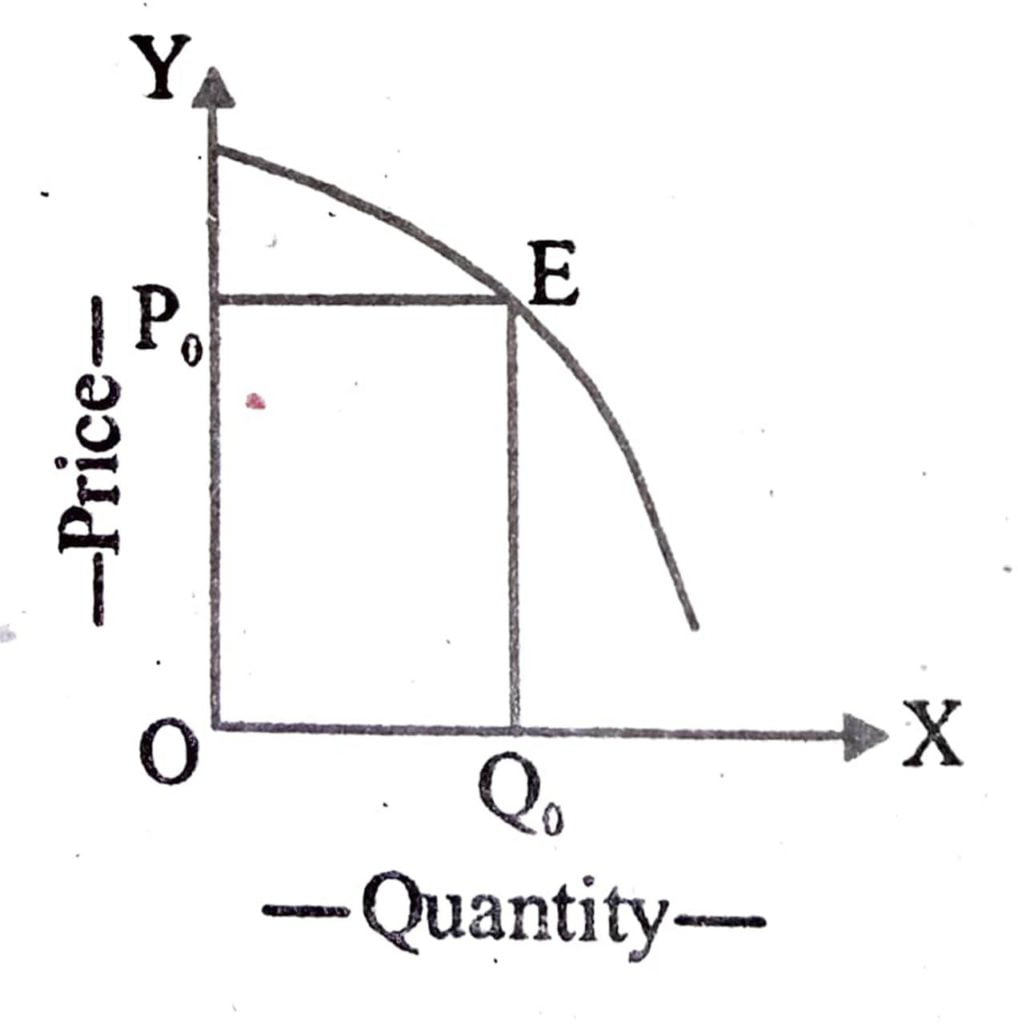
Under oligopoly prices are rigid. Once a price comes to prevail. It continues for a long time in spite of changes in cost and demand. It can explain diagrammatically
Firms tend to stick to the established price (p0) as shown in the diagram which is known as price rigidity.
In such a situation demand curve become kinked at the prevailing price. Any increase in price above it by any seller will considerably reduce the sales. Because rivals firms will not follow this price increase. The demand curve above the established price is elastic. On the other hand, if any seller reduces the price of his product below the established price his rivals will also reduce their prices. So the sellers is not again joining to gain from price cut. Though he will increase his sales to limited extend his profit would be less than before. This is because, the portion of the kinked demand curve below the established price is less elastic. Therefore he would stick to the prevailing market price at the kinked point E which remains rigid.
9. Explain why short–run profit earned by a monopolistic competitive firm do not continue in the long-run.
Ans: Short–run profit earned by a monopolistic competitive do not continue is the long run. Because under monopolistic competition a large number of firms produce differentiated product which belong to the same class. In other words, these firms sell different varieties of the same product. Each seller processes a little market power because it sell a differentiated product yet several firms complete with one another because their products are close substitutes.
10. Explain why the demand curve facing a firm under monopolistic competition is negatively sloped.
Ans: Demand curve of a firm under monopolistic is negatively sloped. Their negative slope indicates that more of commodity can be sold at a lower Price. The demand curve in monopolistic competition is more elastic because products have more close substitutes.
SHORT ANSWER QUESTIONS TYPES -l : (MARKS : 4)
1. Describe the price output determination of a firm under monopolistic competition during the short run.
Ans:
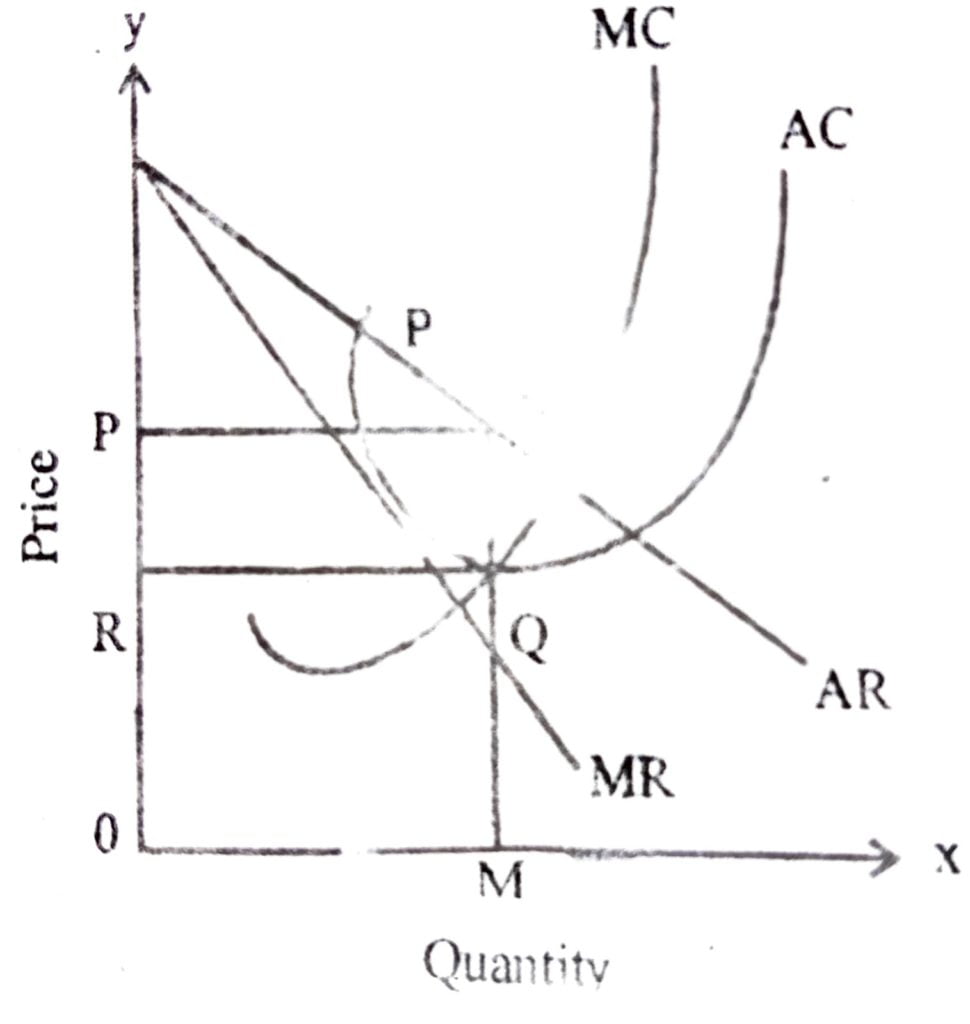
Under monopolistic competition, the average revenue curve of a firm is a downward sloping curve. It lies below the average revenue curve. Each firm will try to increase the sale of his product either through reduction of price of through sales pressure like advertisement, special service etc. And tries to minimise it’s profit. Each firm will be able to minimise it’s revenue at that stage of production, where his marginal revenue will be equal to its marginal cost (MR=MC). So long the marginal revenue of the firm is higher than its marginal cost, it will be profitable for the firm to increase it’s production. In the above figure, AC and MC curve represents the average cost and marginal cost curves of a firm and AR and MR represents the average revenue and marginal revenue curves of an individual firm under monopolistic competition. In the diagram, the MR curve intersects the MC at point Q, where the equilibrium price is OP and equilibrium output is OM. At this stage of output OM, the average cost is DM and average revenue is KM and this, KD is the super-normal profit per unit. Thus, the total super normal profit is PKDR.
2. The marginal revenue (MR) schedule of a production unit is given below.
Calculate the total revenue (TR) and the average revenue (AR) schedule.
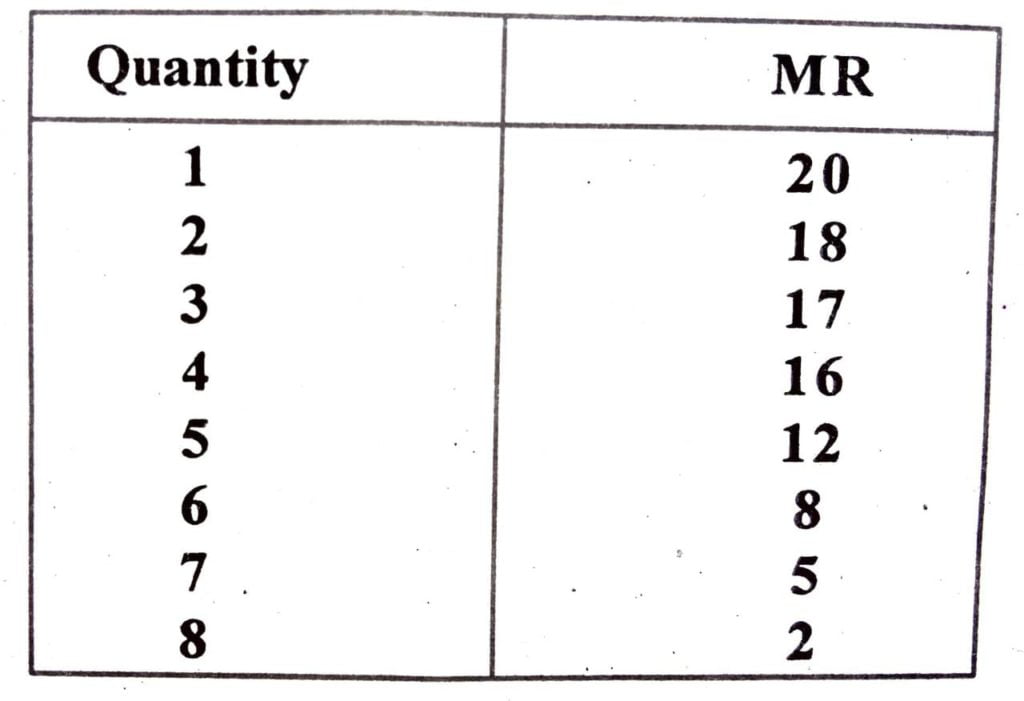
Ans:
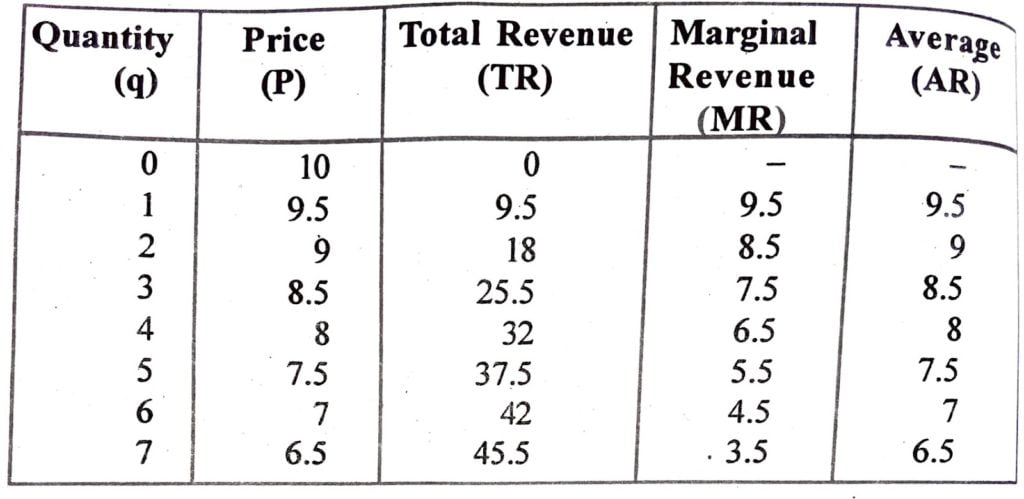

3. The total revenue schedule (TR) of a monopolist is given below:
Calculate the marginal revenue (MR) and demand schedule (AR) of the monopolist.

Ans:
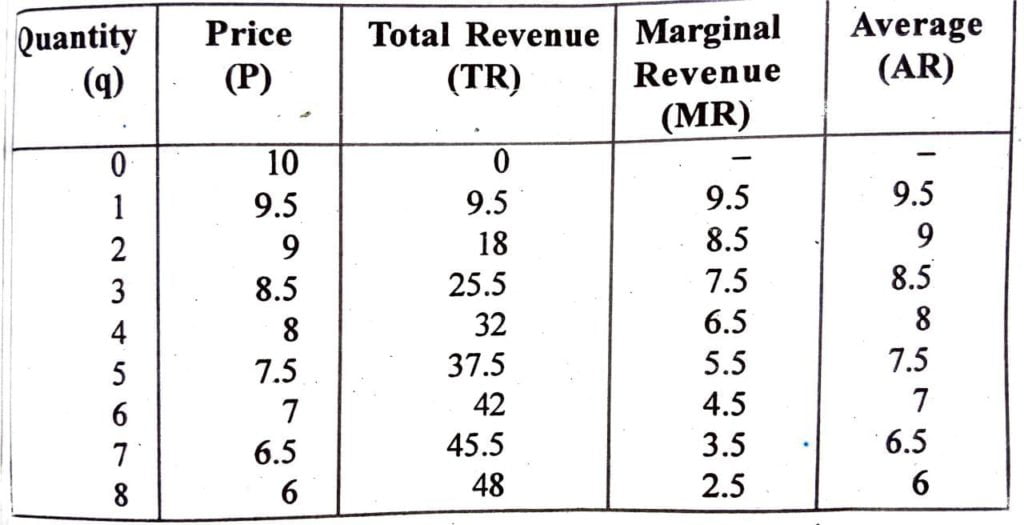

4. The marginal revenue (MR) and marginal cost (MC) schedule of a production unit is given below.
Calculate the equilibrium level of output (Q)
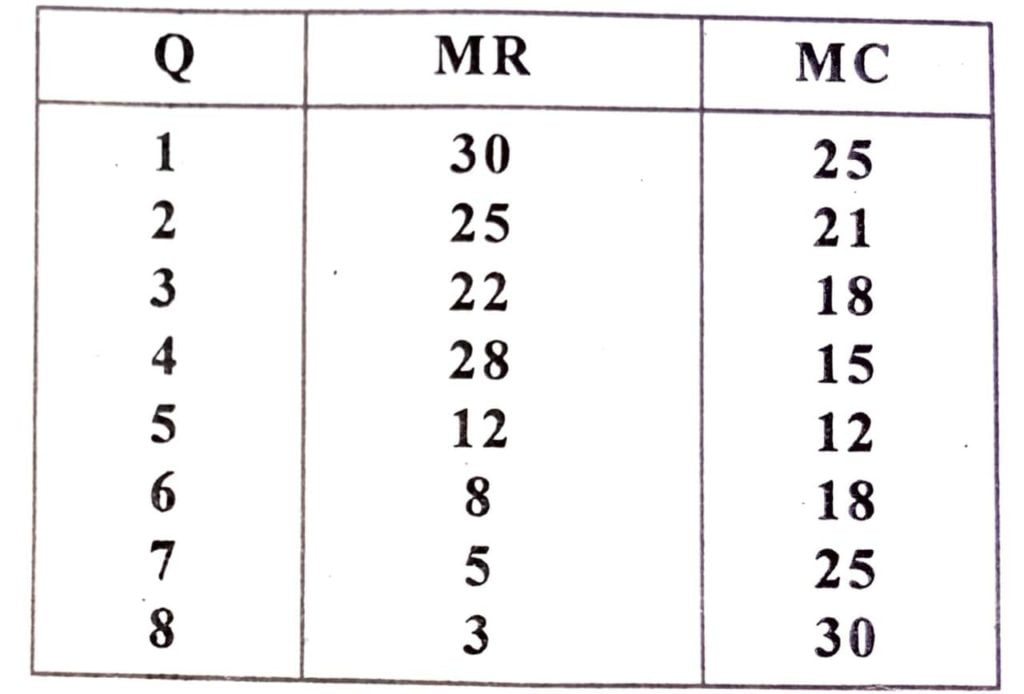
Ans:
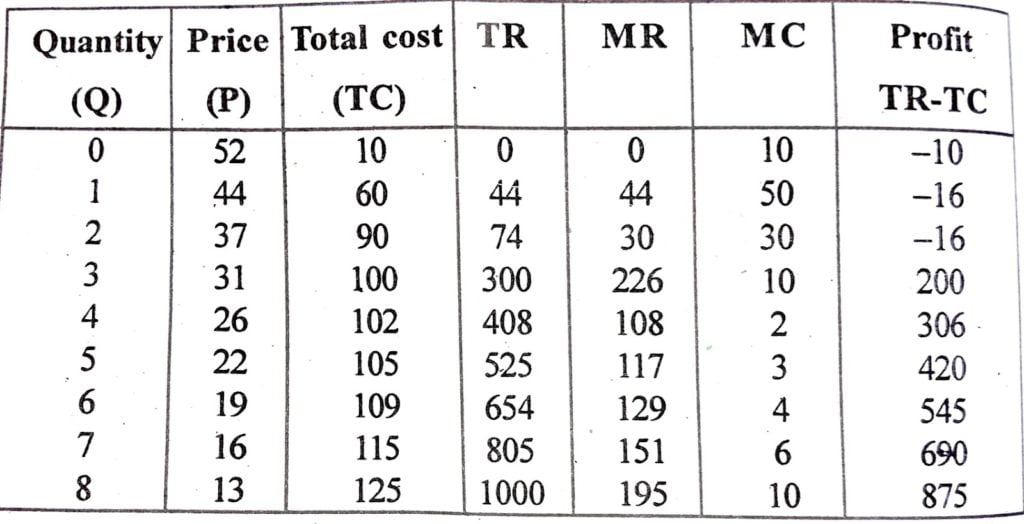
5. Explain why monopoly profit does not go away in the long–run.
Ans: Monopoly profit doesn’t go away in the long run because there is a strong barrier to the entry of new firms into the industry. A firm under perfect competition can’t make abnormal profit in the long run due to free entry of new firms into the industry.
When a monopoly firms earns supernormal profit in the long run, now new firms is able to entry the industry due to same restrictions such as government/ legal restrictions, very huge cost of production, technical efficiency, patent right etc. All these impose no entry into the new firms. Therefore a monopoly can make abnormal profit both in the short run and long run.
In the long run the monopolist has the time to expand his paint or to use his existing plant at any level which will maximise his profit. But due to the prevention of entry it is not necessary for the monopolist to reach an optional scale. That is it is not necessary for the monopolist to build up his plant until he reaches the minimum point of the LAC. Due to lack of competition he need not use his existing plant at an optimum capacity. The necessary condition for a monopolist to stay in business is that he should not make losses in the long run.
6. The average revenue function of a monopolist is given below .
Quantity (Q) 1 2 3 4 5 6 7 8
Average
Revenue(AR) 40 38 35 32 30 28 25 22
― Find out the total revenue and marginal revenue functions. Chapter III
Ans:

7. ‘Monopoly firm is a price market’― explain.
Ans: Monopoly firm has full control over the supply of its product, The firm has full control over the supply of its product because (a) there is no competition in the market and (b) there are barriers to the entry of new firms in the monopoly market (c) there are no close substitutes of the product. Therefore it can influence the market price by quantity at a high price. Hence, the demand here is a constraint.
In fact the firm’s decision to sell a large quantity is possible only at a lower price. Conversely, the firm brings a smaller quantity of the commodity into the market for sale then it will be able to sell it at a higher price. Thus for the monopoly firm the price depends on the quantity of the commodity sold. In other words, price is a decreasing function of the quantity sold. Like perfect competition, the monopoly firm cannot sell any amount of the commodity at the same price.
8. Describe the long―run price output determination of a firm under monopolistic competition.
Ans:
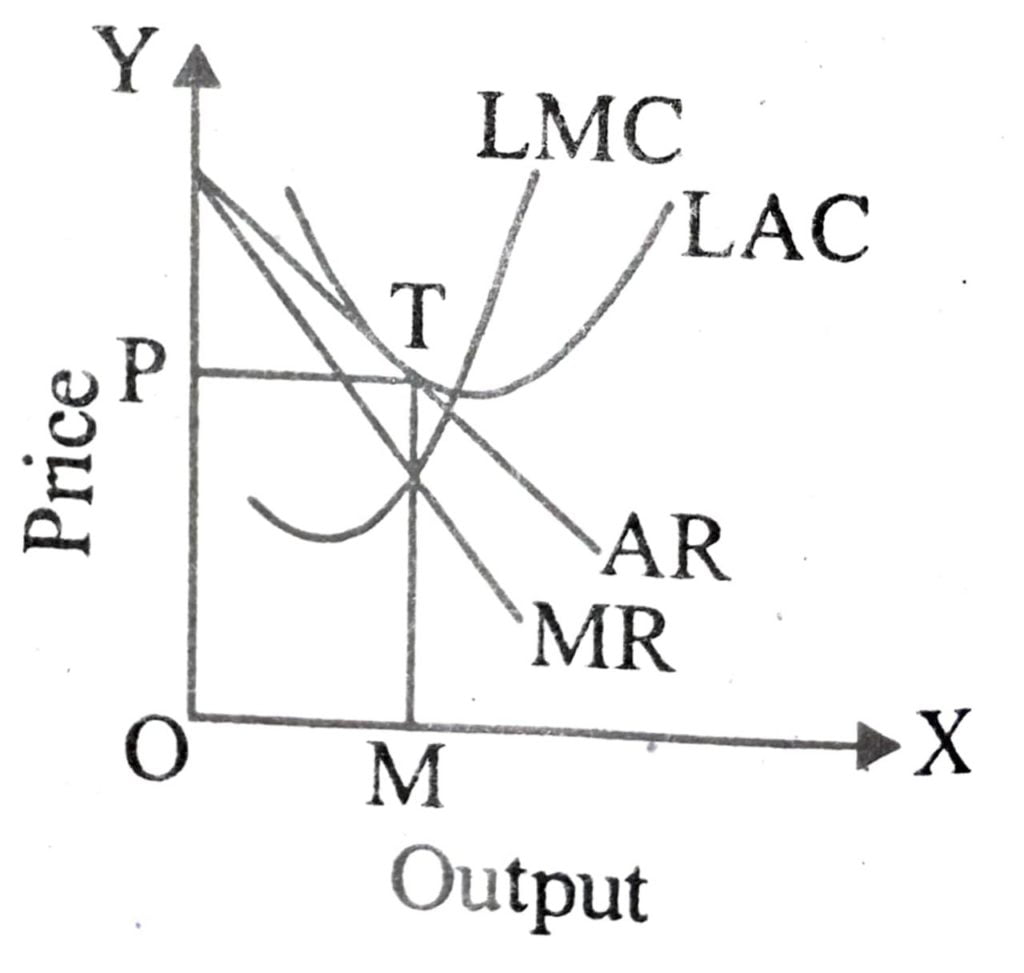
Under monopolistic competition long run price output determination of a firm is shown with the help of a diagram.
In the figure long run marginal revenue and average revenue curve are downward sloping straight line. Long run marginal cost and average cost curve are ‘U’ shaped price and output are determined at that point where average revenue curve tangent to the long run average cost curve. In the long run under monopolistic competition firm suffers a loss. In the diagram the average revenue curve is tangent to the average cost curve at point T.T is the equilibrium point. The equilibrium price is OP and equilibrium out OM.
9. Explain the short-run equilibrium of the monopolistic competition with zero cost.
Ans:
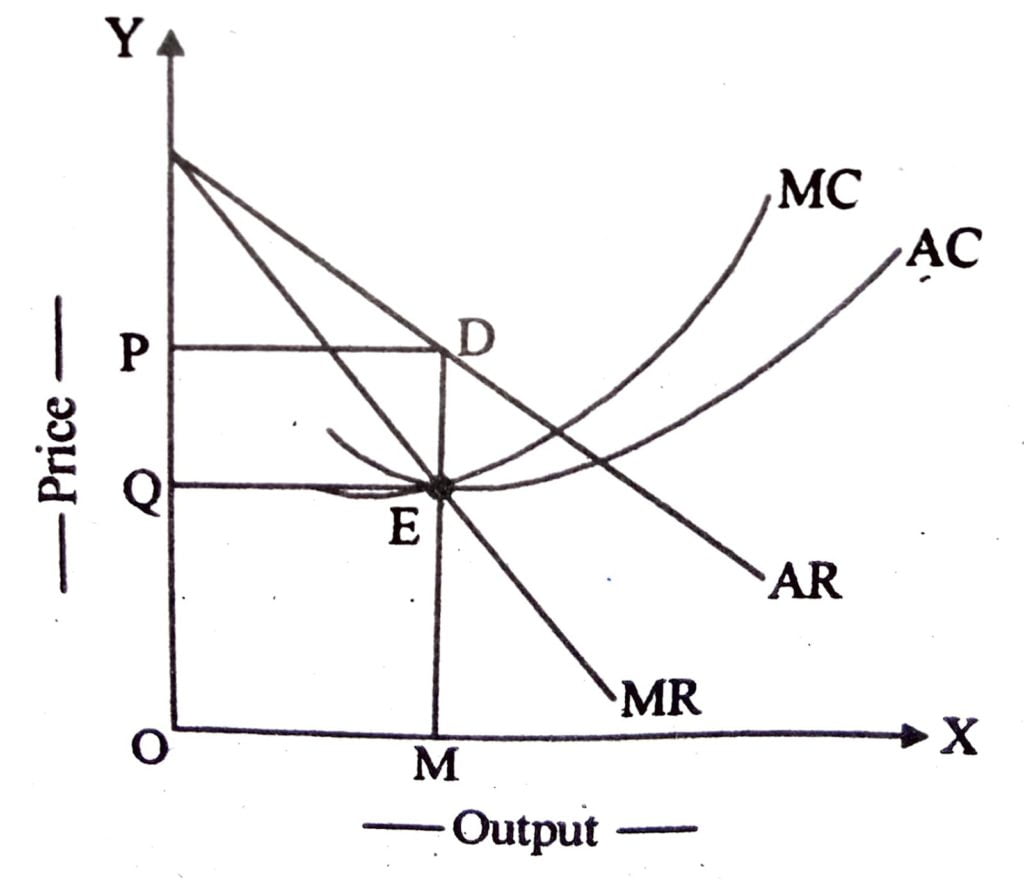
The short run equilibrium of the monopolistic competition is shown in the diagram below. In the diagram, AR is average revenue curve. It slopes downward to the right. MR is the marginal revenue curve. It lies below AR, AC and MC are average cost and marginal cost curves respectively, MC is below AC when AC is falling and MC is above AC when AC is rising. The point where marginal cost is equal to marginal revenue is the point that determines price and quality.
Therefore, from point E a line is drawn to point D on the average revenue curve. This gives the equilibrium price which is OP and equilibrium output OM.ED is super normal profit per unit. Hence EDX QE i.e. PQED is total profit.

Hi, I’m Dev Kirtonia, Founder & CEO of Dev Library. A website that provides all SCERT, NCERT 3 to 12, and BA, B.com, B.Sc, and Computer Science with Post Graduate Notes & Suggestions, Novel, eBooks, Biography, Quotes, Study Materials, and more.


